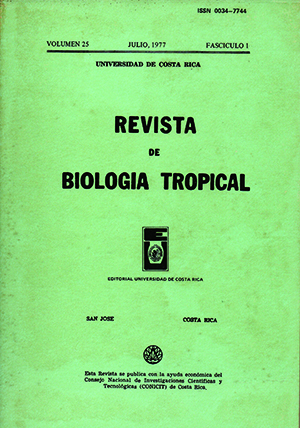Resumen
Un reconocimiento intensivo de la cuenca de la laguna Arenal para investigar el efecto que tendría la construcción de una represa por el Instituto Costarricense de Electricidad (ICE) sobre la ictiofauna de ésta y la de las cuencas de los ríos Bebedero y Tempisque dio como resultado un total de 25 especies de peces para esa zona. Con muestreos similares en la vertiente pacífica de Guanacaste se informa sobre 22 especies para la cuenca del Bebedero y 21 para el Tempisque. Entre estas dos cuencas existe un total de 26 especies.
Se analizó la distribución altitudinal y geográfica de estas ictiofaunas y los parámetros ecológicos que influyen en su distribución. Se clasificó los peces con base en la velocidad de corrientes de los ríos en que se encuentran típicamente y se concluyó datos sobre la temperatura, tipo de substrato y ancho y profundidad de los ríos donde habitan.
La velocidad de corriente y tamaño del río pueden ser factores limitantes para determinar los límites superiores de altura de algunos peces. La temperatura y la competencia interespecífica juegan un papel importante en la determinación de los límites inferiores de la distribución altitudinal de estos peces.
El factor de velocidad de corriente y los cambios resultantes en la temperatura, concentración de oxígeno disuelto y otros factores, son de principal importancia en la distribución horizontal o geográfica de los peces estudiados. Se encontró algunas especies estenotópicas con una distribución intermitente, probablemente debido a una escasez de hábitats apropiados.
Citas
Bussing, W.A. 1975. Utilidad de los recursos pesqueros nacionales. Rev. Univ. Costa Rica, 41: 17-21.
Bussing, W.A. 1976. Geographic distribution of the San Juan ichthyofauna of Central America with remarks on its origin and ecology, p. 157-175. In T.B. Thorson (ed.), Investigations of the ichthyofauna of Nicaraguan lakes. University of NebraSka Press, Lincoln.
Costa Rica. Instituto Costarricense de Electricidad 1974. Plantas y proyectos de generación eléctrica del Instituto Costarricense de Electricidad. I.C.E., Costa Rica. 12 p.
Ham, M.H. 1972. The amount of space available for marine and freshwater fishes. Fish. Bull. U. S., 70: 1295- 1297.
León, J. 1952. Nueva geografía de Costa R ica. Librería La Española, Costa Rica. 170 p.
U.S. AID Resources Inventory Center 1965. Amílisis regional de recursos físicos, Centroamérica y Panamá. A.I.D. Resources Center, Washington, D.C. Texto 33 p., láminas 33 p.
##plugins.facebook.comentarios##

Esta obra está bajo una licencia internacional Creative Commons Atribución 4.0.
Derechos de autor 1977 Revista de Biología Tropical


